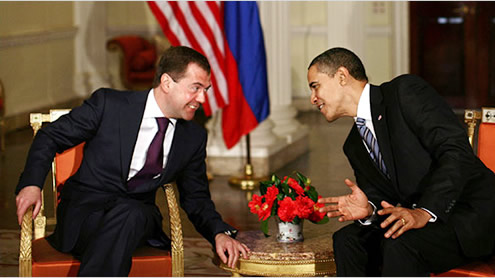 The United States and Russia, according to media reports, were close to signing an agreement on missile defence cooperation on the margins of the G-8 summit meeting in May. The details of the proposal are not public, but the disappointment over not achieving the agreement is. It’s true that not since the failure at the Reykjavik summit 25 years ago to stem deployment of offensive nuclear missiles in Europe have Russia and the United States faced off on such a serious arms issue. But let’s get a grip. It’s not 1986, and America and Russia are not squared off in a nuclear stalemate. We’re discussing defensive missiles – not offensive ones. And we’re discussing cooperation – not confrontation. Or at least we could be.
The United States and Russia, according to media reports, were close to signing an agreement on missile defence cooperation on the margins of the G-8 summit meeting in May. The details of the proposal are not public, but the disappointment over not achieving the agreement is. It’s true that not since the failure at the Reykjavik summit 25 years ago to stem deployment of offensive nuclear missiles in Europe have Russia and the United States faced off on such a serious arms issue. But let’s get a grip. It’s not 1986, and America and Russia are not squared off in a nuclear stalemate. We’re discussing defensive missiles – not offensive ones. And we’re discussing cooperation – not confrontation. Or at least we could be.
The public is not privy to the details of the recently aborted agreement, but there’s so much confusion over terms like “joint” and “sectors” and misunderstanding of actual system capabilities that it’s a wonder we can even schedule a meeting in which to disagree. Although it’s not 1986, we should take a page from our predecessors’ playbook. A year after the failure at Reykjavik to resolve the nuclear stand-off in Europe, both sides achieved a historic agreement to eliminate an entire class of offensive missiles. All we need today is a clear understanding of the problem and some common-sense thinking.
Here is the problem. Today, to prevent a nuclear missile attack, the United States and Russia are pursuing two fundamentally opposing strategies: one a missile defence system, and the other the capability to defeat a missile defence system. America and Russia are aiming for the same goal – freedom from a nuclear missile attack – but the strategies are antithetical. The reasons are that Russia knows it cannot afford a robust missile defence system, but the United States believes it can. The United States does not need Russian cooperation to deploy missile defence; it is already doing so. Washington, however, does need Russian cooperation to prevent a missile attack against the United States. That is because, for the foreseeable future, Russia will retain the capacity to attack the American homeland with nuclear missiles despite our missile defence deployments. So, US leaders must address Russian concerns or risk actually increasing the threat of nuclear attack by the very deployment we hoped would reduce that threat.
Each side has set conditions reminiscent of Cold War days. What we need now are ideas that reflect our improved relationship. Here are some thoughts: Jointly develop separate systems: The reality is that today our two systems are different and we don’t talk to each other. But who in the 1960’s would have predicted that competing US and Russian space programmes would be working together by the 1970’s? Or that by 2011, the United States would rely on Russia to send its astronauts into space? Maybe we should let NASA and the Russian Space Agency work this out. Both Russia and America must make their technologies more open to each other so that coordination can be achieved between the two systems. This is a job that industry can lead with government permission.
Steps by the United States: It’s time for America to realise that Russia is not the adversary it once was. I am a proponent of missile defence, but I have enough experience to know that it will always remain a limited system, capable of protecting our forces, allies and homeland only partially. Let’s promise Russia in writing what we already know is reality – our system will remain limited and will not be directed against Russia.
Steps by Russia: It’s also time for Russia to realise that the United States is not its enemy, and to admit that NATO is not a threat. Every new radar site or missile defence launcher is not an existential danger to Russia. Russia should agree to share its major military advantage – its geography. US/NATO radars in Russia’s southern tier would be ideal for defence against missiles from Iran. And, for US engagements by the Aegis SM3 missiles, Russia should grant permission to intercept enemy ballistic missiles over or near Russian territory.
There are many other steps we can take, such as a serious and open joint assessment of the ballistic missile threat, joint research and development agreements, and joint training. Perhaps we could even expand on our 1987 success in eliminating our own intermediate range ballistic missiles by encouraging the rest of the world to follow suit. Let’s emulate 1987 and not 1986. – Khaleejtimes












